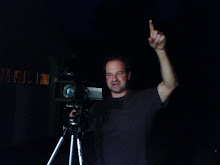While probing my mind trying to name this blog, I found the obvious to be an excellent choice. It has a rather sophisticated feel to it, don't you think?
It's nothing more than the basic reason why a series of still images is seen as a motion picture. When I taught the Youth Animation Workshop at the Garden State Film Festival, "persistence of vision" was the first item on the agenda. The handouts I created for the class, included a checkerboard pattern (actually more of a Purina logo) which I asked the kids to stare at for 10 seconds then close their eyes. Guess what they saw? By the way (aka BTW) here is a link to the handout (http://www.earlyfilms.net/anim workshop/Animation_Handouts.pdf). I then showed them 35mm snippets from animated films to illustrate the progression of images, followed by a 16mm screening of Disney's "The Old Mill" - which also served to demonstrate the effect of the multi-plane animation stand.
With the film projector, I used the inching knob to give them a frame-by-frame demonstration of how a motion picture really works.
Those born into today's world of electronic film, I believe miss the basic understanding of how it all works. So much is lost amid electrons flowing through the computers and other devices. Knowing how to press the buttons and make it work is simply not enough. Understanding the basic organic concepts provides a much more intuitive understanding and enhances the creative process.
I often get the impression that many of today's youth seem to think their computers, iPods and other devices are mostly the work of their contemporaries with little regard to the evolution of technology over the years and those responsible. Edison's tinfoil phonograph is ultimately the reason we have CD's and DVD's . It's interesting that if you break open a CD or DVD you will find something that looks like tinfoil!
It is because of my primary experience editing actual film that non-linear editing was such a blessing and a breeze for me when it came along. The original concepts are all there; film hanging in bins, cutting and pasting, A and B-rolls (and beyond), multiple audio tracks that can be easily edited independent of the visual elements.
Any of you who like myself once cut video tape-to-tape know what a nightmare that was when changes were made after the fact! Incidentally, my first non-linear experience was on the IMMIX VideoCube! Anyone remember that?
"Persistence of Vision" also refers to my goals as a filmmaker. I have too many years of accumulated ideas for features, shorts, animation and TV series to not "persist" in my efforts to make it all happen. The affordability and sophistication of today's technology puts these projects much more within reach.
It's nothing more than the basic reason why a series of still images is seen as a motion picture. When I taught the Youth Animation Workshop at the Garden State Film Festival, "persistence of vision" was the first item on the agenda. The handouts I created for the class, included a checkerboard pattern (actually more of a Purina logo) which I asked the kids to stare at for 10 seconds then close their eyes. Guess what they saw? By the way (aka BTW) here is a link to the handout (http://www.earlyfilms.net/anim workshop/Animation_Handouts.pdf). I then showed them 35mm snippets from animated films to illustrate the progression of images, followed by a 16mm screening of Disney's "The Old Mill" - which also served to demonstrate the effect of the multi-plane animation stand.
With the film projector, I used the inching knob to give them a frame-by-frame demonstration of how a motion picture really works.
Those born into today's world of electronic film, I believe miss the basic understanding of how it all works. So much is lost amid electrons flowing through the computers and other devices. Knowing how to press the buttons and make it work is simply not enough. Understanding the basic organic concepts provides a much more intuitive understanding and enhances the creative process.
I often get the impression that many of today's youth seem to think their computers, iPods and other devices are mostly the work of their contemporaries with little regard to the evolution of technology over the years and those responsible. Edison's tinfoil phonograph is ultimately the reason we have CD's and DVD's . It's interesting that if you break open a CD or DVD you will find something that looks like tinfoil!
It is because of my primary experience editing actual film that non-linear editing was such a blessing and a breeze for me when it came along. The original concepts are all there; film hanging in bins, cutting and pasting, A and B-rolls (and beyond), multiple audio tracks that can be easily edited independent of the visual elements.
Any of you who like myself once cut video tape-to-tape know what a nightmare that was when changes were made after the fact! Incidentally, my first non-linear experience was on the IMMIX VideoCube! Anyone remember that?
"Persistence of Vision" also refers to my goals as a filmmaker. I have too many years of accumulated ideas for features, shorts, animation and TV series to not "persist" in my efforts to make it all happen. The affordability and sophistication of today's technology puts these projects much more within reach.

No comments:
Post a Comment